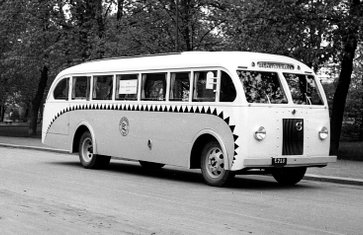The story about N200
Swedish bus operator Ernst Carlson, born 1896, was a growing up as cars were introduced. He was educated in farming and got his driving license in early days. As lots of other poor Swedes he went to USA to make money. Back in Sweden he ordered his first new petrol engine Volvo touring bus in 1936 as holiday travel was getting popular.
In 1939 import of fuel, oil and tyres was reduced due to the war. The bus had to be sold.
In autumn 1947 Mr Carlson ordered a new bus, based on Volvos diesel powered chassis B 513. The coachbuilder ”Skeningeverken” was decided to build the body by Mr Carlsons instructions. The standard body was extended to a wider, longer and higher Coach then usual. The wheelbase was extended from 5,2 to 6,0 meters, which was disapproved by chassis manufacturer Volvo. The new vehicle was too much experimental.
N200 Volvo 1948
The new bus was completed in April 1948, a most extraordinary comfortable touring coach with panorama roof, spacious airplane seats, kitchen, toilet, radio and fluorescent light. It was only built in one single number. Unfortunately the 95 hp engine was to weak for the 12 tons vehicle. The project got very expensive, about three times more than the cost of a standard bus.
For ten years Mr Carlson made exciting expeditions around all Europe by his bus. The kitchen was used for cooking as there was lack of grocery and restaurants the first years past the World War II.
A journey from Sweden to Paris lasted for about ten days. In 1953 when Queen Elisabeth was crowned Mr Carlson arranged a trip to London. Vienna was visited once and the bus transported by train trough the Brenner pass to Italy.
In 1958 the Worlds-Fair Expo 58 in Belgium was visited.
Compared to new buses in 1950-ties the N200 had an old fashioned impression, it was slow and small. It was impossible compete to buses with double engine power and seats. In 1956 Mr Carlson was broken when authorities reduced the numbers of passengers in N200 from 30 to 26 to reduce overload. For profit four most important seats. The last trip was arranged to Lübeck in summer 1959 and since the bus was withdrawn from service.
When Mr Carlson died in 1977 the famous bus was still in his garage. It was sold to a group of car enthusiasts but not carefully stored. In 2005 the remains of the once extraordinary bus was in a very bad condition. The body was seriously damaged by a soggy storing place. The roof had collapsed and there was a smell of mould inside.
From 2005 to 2014 the bus was completely renovated with a new roof, all mechanics was reconditioned including a new 115 hp engine and gearbox installation. The interior has got a makeover but seat textile is still in original from 1948.
In 2018 the bus became 70 years old, it has during the last five years been in service for more than 10.000 km in an average speed of about 75 km/h. The bus has not been abroad for 60 years. Will there be another Europetour?
N4444 volvo 1936
